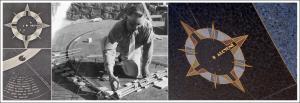Artist Oskar Hansen works on Monument Plaza at Hoover Dam, which he created for the 1935 dedication. The plaza floor is a giant star map, indication the positions of key stars at the moment of the dedication (left images). The layout is festooned with astronomical details, including a depiction of the Pleiades star cluster and its brightest star, Alcyone, shown at the time of the dedication (top left) and in more modern times (right). (U.S. Bureau of Reclamation (3); Jeremy Faludi/Wikipedia (right))
You are here
Precession
The Sun will change addresses tonight. It’ll move from Ophiuchus to the next constellation over, Sagittarius. That’s where it’ll reside at the winter solstice, next week.
Sagittarius hasn’t always been the Sun’s home for the solstice, though. A couple of thousand years ago, the Sun was in Capricornus. And a century and a half from now, it’ll move into Ophiuchus.
The change is caused by precession — a slow “wobble” in Earth’s axis. It causes the Sun to slide through the background of stars over the millennia. It also causes the north pole to trace a circle on the sky. It takes almost 26,000 years to make one circle. And during that time, Earth has different “north stars.
An artist used precession to honor Hoover Dam. Oskar Hansen designed Monument Plaza. It includes a 14-story flagpole, two 30-foot statues, and a terrazzo floor that indicates the date of the dedication — September 30th, 1935 — with the help of the stars.
Today, the North Star is Polaris. A line from the flagpole through a wide ring around it points to the position of Polaris at a precise time on the night of the dedication. Another line points to Thuban, the pole star when Egypt built the Great Pyramid. In fact, that was one of Hansen’s inspirations: Architects used Thuban to align the pyramid — another great work of human history.
And yet another line points to the bright star Vega. It will serve as the pole star in 12,000 years — thanks to precession.
Script by Damond Benningfield
Get Premium Audio
Listen to today's episode of StarDate on the web the same day it airs in high-quality streaming audio without any extra ads or announcements. Choose a $8 one-month pass, or listen every day for a year for just $30.



